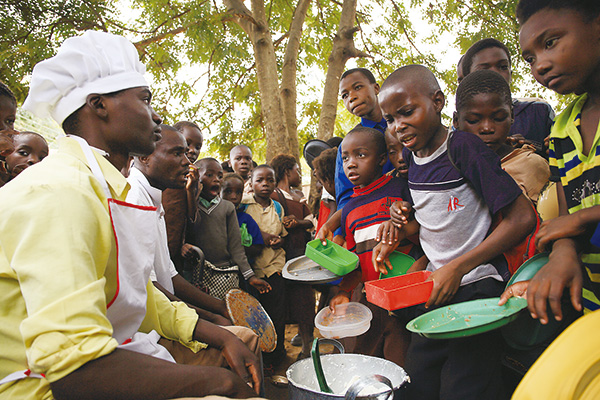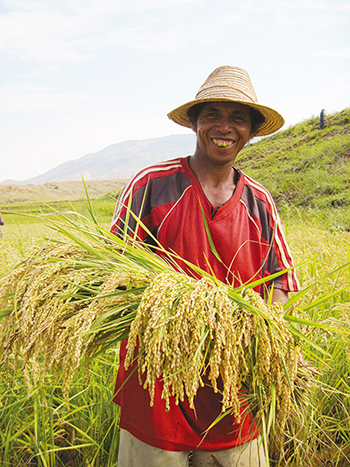(4) Food Security and Nutrition
According to “The State of Food Insecurity in the World 2015 (SOFI2015),” a report which has been jointly prepared by the Food and Agriculture Organization of the United Nations (FAO), the International Fund for Agricultural Development (IFAD) and the World Food Programme (WFP), positive trends were found – the number of undernourished people in the world has decreased by more than 160 million over the last decade and by more than 200 million since 1990-92. However, the 2014-2016 estimates indicate that about 800 million people remain undernourished.
This report expresses the view that the goal to halve the proportion of undernourished people by 2015, which is one of the MDGs, has been reached from a developmental perspective. However, statistically speaking the goal remains unmet. In addition, there is a need for international coordination and multifaceted measures to establish food security (a state where all people, at all times, have access to sufficient, safe and nutritious food), such as establishing a social safety net (a mechanism in which people can live safely and with peace of mind), improving nutrition, providing necessary food assistance, and implementing measures against infectious diseases of livestock.
Furthermore, initiatives to improve nutrition during the first 1,000 days from a mother’s pregnancy to her child’s second birthday, which is particularly effective in addressing the issue of malnutrition, are being promoted.
< Japan’s Efforts >
In light of these circumstances, Japan provides food assistance based on requests from developing countries confronting food shortages. In FY2014, Japan contributed a total of ¥5.57 billion through bilateral food assistance projects in 14 countries.

Pupils receive lunch at the Bulungu Primary and Secondary School in Zambia. (Photo: Atsushi Shibuya / JICA)
Japan also provides assistance in this field through international organizations, mainly through WFP. These include emergency food assistance, support for school feeding programs to increase access to education, and food assistance that promotes participation in the development of agricultural land and of social infrastructure and supports the self-reliance of local communities. In 2014, Japan contributed a total of $156.55 million to WFP projects being implemented around the world.
Meanwhile, Japan provides support for research on the development of varieties conducted by the Consultative Group on International Agricultural Research (CGIAR), which is comprised of 15 agricultural research centers, as well as promoting cooperation through exchanges among researchers.
In addition, Japan also supports the efforts of developing countries to enhance their own food safety. Concerning animal infectious diseases that spread beyond national borders such as foot-and-mouth disease, Japan is reinforcing countermeasures in the Asia-Pacific region, in cooperation with the World Organisation for Animal Health (OIE) and FAO, including the Global Framework for Progressive Control of Transboundary Animal Diseases (GF-TADs). Furthermore, Japan is deeply involved in the Scaling Up Nutrition (SUN) Movement, which internationally leads initiatives to improve the condition of malnutrition, and has pledged to strengthen its assistance.
Madagascar
Project for Rice Productivity Improvement in Central Highland
Technical Cooperation (January 2009 – July 2015)

A farmer participating in the experiment collects harvest at experimental cultivated fields under the project in the Bongolava Region. The happy faces of the farmers are a source of inspiration and courage for the Japanese who provide cooperation. (Photo: JICA)
Madagascar is roughly 1.6 times the size of Japan, and is the fourth largest island in the world. Rice is the staple food in Madagascar and the country consumes 120 kilograms per capita annually, twice that of Japan. Some 1.4 million hectares of land are used for rice cultivation and the country produces around 3 million tons of rice each year. However, annual yields differ widely depending on cyclones and other weather-related factors. This means that about 10% of the rice consumed in Madagascar is imported.
Madagascar formulated the Madagascar Action Plan (MAP: 2007 to 2012), which is the country’s national development plan. The plan includes the target of doubling 2005 rice production (3.42 million tons) by 2012, which is one of Madagascar’s most important reform initiatives.
The Government of Japan started supporting the development and dissemination of primary rice cultivation methods for the country’s central highland, and improvement of coordination among the country’s rice cultivation institutions.
However, Japan and Madagascar faced a critical challenge. To double rice production, they would have to boost production in the highly populated central highland, which is home to Antananarivo, Madagascar’s capital, and Antsirabe, Madagascar’s third largest city.
This project targets five provinces in the central highland. These provinces are located at elevations between around 600 meters and 1500 meters, and have diverse natural environments and ecosystems. The primary forms of rice cultivation there are irrigated cultivation, rain-fed rice cultivation in paddy fields in the bottom of valleys, and cultivation at cooler high altitudes.
Many different steps are needed to improve rice productivity. First, recommended rice varieties should be chosen based on the cultivation method, and an evaluation of the market and farmers should be conducted. The seeds should then be disseminated, and suitable cultivation techniques should also be established and spread.
This project created three basic technical packages. Each is ideally suited to the typical cultivation conditions of a particular province. Specifically, these are irrigation cultivation in Alaotra-Mangoro Province, rain-fed cultivation in Bongolava Province, and cultivation at cool highland regions in Vakinankaratra Province. The project then worked on technical development and dissemination locally.
Activities were held to educate local farmers, mainly at model sites set up in each province. Afterwards, full-fledged technology dissemination began at non-model sites from 2013 and 2014. In addition, the project selected rice varieties, propagated seeds, and created a distribution system.
The lack of agricultural technology instructors was a major problem in Madagascar. Only 104 of the 119 instructors (87.5%) in these primary provinces had technical teaching experience using the technology package in June 2013. However, this increased to 217 of 228 (95.2%) at the time of a survey in February 2015.
The project aimed to increase the average yield of rice famers at model sites by 1 ton per hectare. The actual increase per hectare during the 2011/12 growing season was 0.67 tons. This increase then rose to 1.5 tons in the 2013/2014 season, indicating a major improvement in yield per unit area. This increase shows that the target indicator was fulfilled.

